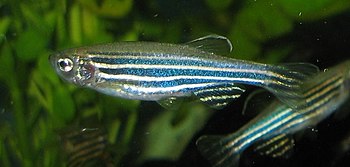 |
| Danio rerio, better known as the zebrafish (Photo credit: Wikipedia) |
However, with an egg-laying species, the aquarist can have a great deal of control over what fish he wants to breed and, just as importantly, when.
It should be said here, that fish will breed whenever they choose inasmuch that should a ripe male and female encounter each other then they will probably spawn spontaneously in the aquarium anyway. Without the care and attention of the fishkeeper, the eggs from egg-scattering species especially will more likely than not be eaten by the other fish in the tank and no fry will be seen. The fry from egg-depositing fish stands a better chance as first of all their parents will prepare and defend a spawning site prior to spawning and also guard any subsequent fry afterward. Let's suppose you want to try your hand at breeding something deliberately and have taken the advice of many experienced fishkeepers by choosing that popular Cyprinid, the Zebra Danio.
First of all, we must ensure that the fish are 'in the mood' to breed rather than just put a male and female together and hope for the best. 'Absence makes the heart grow fonder' is one way of putting it but, realistically, separating the would-be parents is based on a practical rather than emotional supposition.
It is possible that should you simply select a male and female and put them together to spawn then one of them might just have spawned without your knowledge; in which case, the attempt to spawn them would be fruitless.
By separating the sexes prior to spawning, you can ensure that they are in the best condition; feeding them copious amounts of quality food (including live food) will make the females fill with eggs. This conditioning process can take a couple of weeks or so. The best way to do it might be to put the female into the breeding tank first before introducing the well-fed male later.
Sexing the fish is fairly straightforward: the male fish is more slender than the female and if you look at a female, even when she is not full of eggs, there is a definite kink in the horizontal stripes along the body just to the rear of the dorsal fin.
Like all Cyprinids, the Zebra Danio is no respecter of new-laid eggs, including its own. There are several ways to prevent egg eating. Any method that separates the adult fish from reaching their newly-laid eggs is acceptable.
There is no reason why you cannot 'flock spawn' fish. If you have several Zebra Danios then separating all the females from all the males during the conditioning period should give you more Zebra Danio fry than you'd believe possible upon the adults' reunion! But there's still the problem of egg protection.
The answer is to drape a piece of fine netting across the entire water surface area of the spawning tank so that it hangs a few centimeters below the surface; weight the corners down with small pebbles. Now all that is needed is to introduce all the preconditioned fish (both sexes) into the water above the net.
When the males chase the females, any eggs that are released and fertilized then fall through the net into the tank beneath before the adults have time to realize what's going on. The eggs are safe! In order to return the adult fish to their previous aquarium all you do is lift out the net (take the pebbles out first!). The fish are caught all at once with no stress at all.
Meanwhile, the fertilized eggs are quietly hatching and in a few days, you will see what looks like tiny splinters of glass hanging on the sides of the aquarium. These are your new Zebra Danios.
Because they are not exactly sizeable fry, they will require quite small particle-sized food at first. There are preparations of liquid fry food available at your aquatic store and it's a simple task to add a few drops of this at the recommended times to their tank. It may help if you keep a low-level light burning over their tank so that they can feed 24 hours a day.
It is important during these first few days not to over-feed - a difficult task, as you'll never be exactly sure how many baby mouths you've got to feed. Therefore, regular partial water changes are of the highest importance, if water conditions in the nursery tank are not to be compromised.
As the fry grow, then the feeding routine can mirror that outlined earlier for livebearers, with a gradual progression on to larger particle foods. Again, spacing out of fry into larger tanks may be necessary.
|


